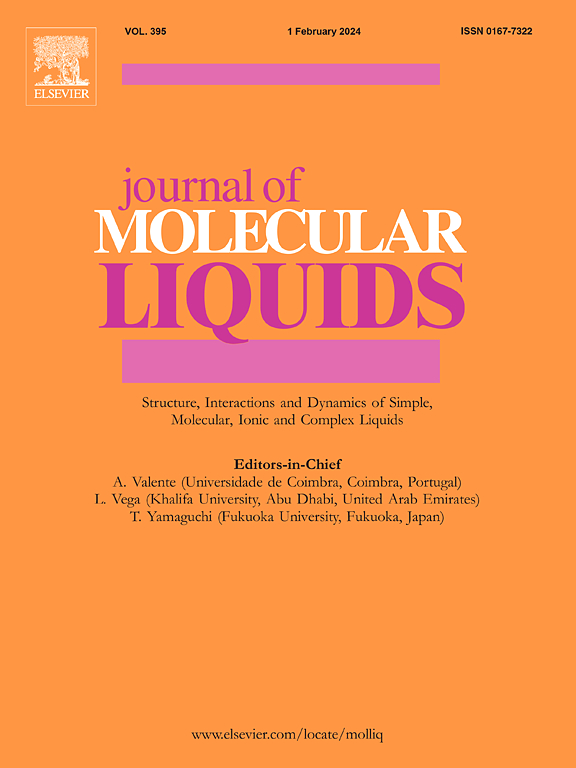对称液晶二聚体上的极性末端取代基:合成、光物理研究、介形和DFT研究
IF 5.3
2区 化学
Q2 CHEMISTRY, PHYSICAL
引用次数: 0
摘要
报道了一种新型的对称液晶二聚体,其特征是具有亚甲基醚连接的柔性间隔和不同末端极性取代基的三环棒状单体。二聚体分子中横向大体积甲氧基的存在增强了分子间的相互作用,改善了中间相的稳定性。强调了二聚体的光物理、热稳定性、液晶行为和化学反应性参数。化合物表现出良好的热稳定性,其中二聚体中三氟碳的存在表现出较高的热稳定性。极性二聚体在溶液和固体薄膜中具有较大的Stokes位移(~ 8353-11,912 nm)和有趣的光物理行为。溶液中二聚体分子的光学带隙在半导体范围内(2.1 ~ 2.8 eV),而在固体薄膜中发现二聚体4FV-6的光学带隙最小(1.9 eV)。它们的荧光量子产率受浓度和溶剂极性的影响较大,荧光效率较高。所有二聚体都表现出广泛的向列相,除了氟取代二聚体在最低的清除温度下表现出额外的对映性Nx。一项DFT研究探讨了它们的结构和电子特性,包括几何优化、TDDFT、CDFT和ESP分析。TDDFT在吸收光谱中显示出与溶剂相关的红移,极性溶剂稳定激发态。偶极矩和反应性分析表明,4CNV-6的极性最高,而4NO2V-6的亲电性最强。本文章由计算机程序翻译,如有差异,请以英文原文为准。

Polar terminal substituent on symmetrical liquid crystal dimers: Synthesis, photophysical studies, mesomorphism and DFT studies
A novel symmetrical liquid crystal dimer has been reported featuring a three-ring rod-shaped monomer with methylene ether-linked flexible spacers and different terminal polar substituents. The presence of lateral bulky methoxy groups in dimer molecules enhances intermolecular interactions and improves mesophase stability. The photophysical, thermal stability, liquid crystalline behaviour, and chemical reactivity parameters of dimers have been highlighted. The compounds show good thermal stability, among them presence of trifluorocarbon in the dimer shows higher thermal stability. The polar dimers are fluorescent with a large Stokes shift (∼8353–11,912 nm) and interesting photophysical behaviour in solution and solid thin films. The optical band gap of the dimer molecule in the solution is in the range of a semiconductor (2.1–2.8 eV), whereas the dimer 4FV-6 is found to exhibit the lowest value in solid thin films (1.9 eV). Their fluorescence quantum yield is greatly affected by concentration and solvent polarity, signifying higher fluorescence efficiency. All dimers exhibited a broad range of enantiotropic nematic phases, except fluoro-substituted dimers exhibit additional enantiotropic Nx with the lowest clearing temperature. A DFT study explored their structural and electronic properties, including geometry optimization and TDDFT, CDFT, and ESP analyses. TDDFT revealed solvent-dependent redshifts in absorption spectra, with polar solvents stabilising excited states. Dipole moment and reactivity analyses showed 4CNV-6 had the highest polarity, while 4NO2V-6 was most electrophilic.
求助全文
通过发布文献求助,成功后即可免费获取论文全文。
去求助
来源期刊

Journal of Molecular Liquids
化学-物理:原子、分子和化学物理
CiteScore
10.30
自引率
16.70%
发文量
2597
审稿时长
78 days
期刊介绍:
The journal includes papers in the following areas:
– Simple organic liquids and mixtures
– Ionic liquids
– Surfactant solutions (including micelles and vesicles) and liquid interfaces
– Colloidal solutions and nanoparticles
– Thermotropic and lyotropic liquid crystals
– Ferrofluids
– Water, aqueous solutions and other hydrogen-bonded liquids
– Lubricants, polymer solutions and melts
– Molten metals and salts
– Phase transitions and critical phenomena in liquids and confined fluids
– Self assembly in complex liquids.– Biomolecules in solution
The emphasis is on the molecular (or microscopic) understanding of particular liquids or liquid systems, especially concerning structure, dynamics and intermolecular forces. The experimental techniques used may include:
– Conventional spectroscopy (mid-IR and far-IR, Raman, NMR, etc.)
– Non-linear optics and time resolved spectroscopy (psec, fsec, asec, ISRS, etc.)
– Light scattering (Rayleigh, Brillouin, PCS, etc.)
– Dielectric relaxation
– X-ray and neutron scattering and diffraction.
Experimental studies, computer simulations (MD or MC) and analytical theory will be considered for publication; papers just reporting experimental results that do not contribute to the understanding of the fundamentals of molecular and ionic liquids will not be accepted. Only papers of a non-routine nature and advancing the field will be considered for publication.
 求助内容:
求助内容: 应助结果提醒方式:
应助结果提醒方式:


